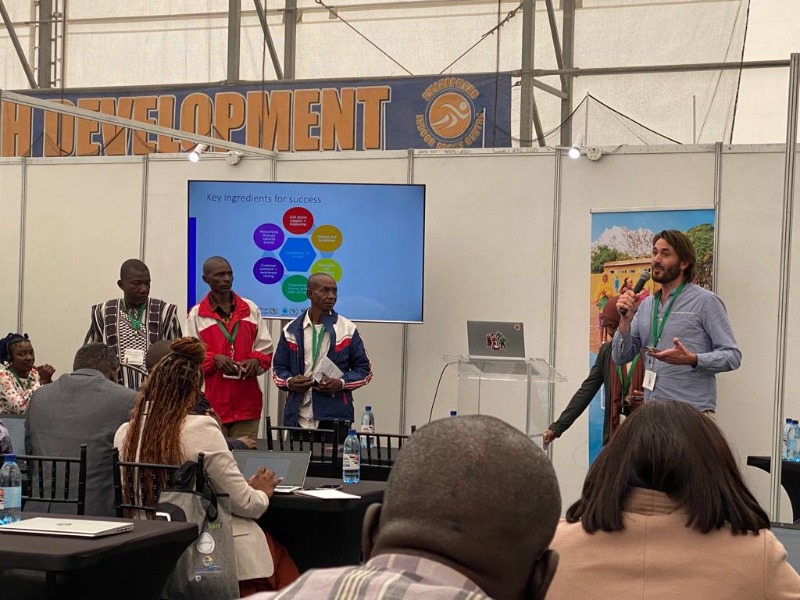- Equity, inclusion and sanitation workers
- Sanitation workers
- Equity, dignity, caste and gender aspects for sanitation workers
- Experiences from mobilisation of Sanitation Workers in African cities; The 2023 AfricaSan7 conference
Experiences from mobilisation of Sanitation Workers in African cities; The 2023 AfricaSan7 conference
3792 views
- lourdesv
-

- Moderator
- Arquitecta, trabajando en temas de agua, saneamiento y medio ambiente desde el año 2003, creo en estrategias de educación ambiental y cambio de comportamiento. En mi día a día trato de dejar un mundo mejor al prójimo.
Less- Posts: 34
- Likes received: 13
Re: Experiences from mobilisation of Sanitation Workers in African cities; The 2023 AfricaSan7 conference
Particularly noteworthy are those techniques exclusive to Africa due to urbanization circumstances but gradually emerging in Latin America. When it comes to manual emptying of septic latrines, various methods and technologies are employed: Manual pumping systems: These systems utilize hand pumps to extract sludge from latrines, a practice common in both Africa and LAC. Vacuum and micro-vacuum tanks: Motorized vacuum tankers, like the "vacu-tug," employ suction to remove sludge, offering a more hygienic alternative. This method finds popularity in LAC. Collection method: In areas inaccessible to larger extractor trucks, a simpler method known as "pickup" is utilized, predominantly in Africa but potentially growing in necessity, especially in Brazilian favelas. Dehydrating latrines: This method diverts urine from the pit, and the remaining feces can serve as a soil conditioner for certain crops, if managed correctly.
Regarding the dehydration method, I'm interested in exploring experiences from Africa and Latin America. Bolivia, particularly in El Alto, La Paz, showcases an exemplary initiative where urine is transformed into solid fertilizer at a Urine Treatment Plant, while dehydrated feces are processed in a vermifilter plant, as illustrated in this VIDEO 1 and VIDEO 2 .
Nevertheless, prioritizing safety precautions during manual emptying is paramount to safeguard workers and communities from health risks associated with pathogens in excreta. Proper equipment cleaning and hygiene maintenance throughout the process are indispensable. Let's delve into the commonalities between Africa and Latin America concerning the health challenges faced by sanitation workers engaged in manual latrine emptying: Health risks: Both regions witness healthcare workers encountering exposure to toxic gases, such as ammonia and carbon monoxide, accumulated in septic tanks and sewers. Symptoms like chronic cough, fatigue, and difficulty breathing are prevalent among these workers. Marginalization and lack of legal protection: Informal status without legal rights or protection characterizes many healthcare workers in both regions, leading to societal invisibility and potential stigmatization.
Efforts geared toward enhancing sanitation services should prioritize social inclusivity, gender equity, and meaningful participation across both Africa and Latin America.
Me intereso mucho analizar las diferencias y similitudes en este tema entre las ciudades de África y las de Latinoamérica y el Caribe. Para además promover potenciales intercambios Sur – Sur que fortalezca a los grupos identificados de trabajadores de saneamiento. Es interesante primero identificar los métodos o técnicas de vaciado de tanques sépticos o letrinas que se repiten en África y Latinoamérica y cuales debido a las circunstancias de urbanización se dan solo en África, pero poco a poco se están empezando a generar en Latinoamérica
Cuando se trata de vaciado manual de letrinas sépticas, se utilizan varios métodos y tecnologías: Sistemas de bombeo manual: Estos sistemas utilizan bombas manuales para extraer los lodos de las letrinas. Y funcionan tanto en África como en LAC. Cisternas de vacío y micro vacío: Los camiones cisterna de vacío (por ejemplo, “vacu-tug”) son sistemas motorizados que crean succión para eliminar los lodos de las letrinas. Estos sistemas son más higiénicos que los métodos manuales. Estos son muy populares en LAC Método de recogida: En áreas inaccesibles para camiones extractores más grandes, se utiliza un método más simple llamado "recogida". Se baja un recipiente pequeño (por ejemplo, un bidón de 5 o 10 litros) atado a una cuerda a la letrina, se sumerge con un palo y luego se vacía en un recipiente más grande (por ejemplo, un bidón de 20 litros). El lodo recogido se transporta a un camión de plataforma donde se puede almacenar en barriles más grandes. Este es un método más utilizado en África, aunque en las favelas de Brasil es muy probable que sea el método más necesario en el futuro. Letrinas deshidratantes: En las letrinas deshidratantes, la orina se desvía del pozo a un recipiente colector separado o a un recipiente de absorción. Las heces restantes se pueden utilizar como acondicionador del suelo para determinados cultivos si el sistema se ha utilizado correctamente. Sobre este método de letrinas deshidratantes, me gustaría conocer la experiencia en África, en Latinoamérica, en Bolivia tenemos una excelente experiencia en la ciudad de El Alto en La Paz. Puede ver en este VIDEO 1 y VIDEO 2 . La empresa municipal EPSAS, realiza la recolección de orina de las casas y la convierte en fertilizante en una Planta de tratamiento de orina. Las heces deshidratadas también son recogidas y tratadas en un Planta de lombrifiltros.
De todas maneras, las precauciones de seguridad son cruciales durante el vaciado manual para proteger a los trabajadores y a las comunidades cercanas de los riesgos para la salud asociados con los patógenos en las excretas. Es fundamental una correcta limpieza de los equipos y mantener la higiene durante todo el proceso. Exploremos las similitudes entre África y América Latina en el contexto de los trabajadores sanitarios que enfrentan el desafío del vaciado manual de letrinas: Riesgos para la salud: Tanto África como América Latina tienen trabajadores sanitarios que se enfrentan a la exposición a gases tóxicos (como amoníaco, monóxido de carbono y dióxido de azufre) que se acumulan en fosas sépticas y alcantarillas. La tos crónica, la fatiga, los mareos y la dificultad para respirar son problemas de salud comunes entre estos trabajadores. Marginación y falta de protección legal: En ambas regiones, muchos trabajadores sanitarios son trabajadores informales sin protección ni derechos legales. A menudo carecen de visibilidad en la sociedad y pueden ser estigmatizados y marginados.
Los esfuerzos para mejorar los servicios de saneamiento deben priorizar la inclusión social, la equidad de género y la participación significativa en ambas regiones.
Regional SuSanA Coordinator (Latinoamérica)
Directora de comunicación AGUATUYA
Calle Nicolás Ortiz no. 33 (a media cuadra de la Av. Calampampa)
Tel (591) 4 424 2164
Casilla 6264
Cochabamba – Bolivia
Siguenos:
www.aguatuya.org
www.facebook.com/aguatuya
www.susana.org/en/mailinglist-latinoamerica
Please Log in to join the conversation.
You need to login to reply- LeylaKhalifa
-
Less
- Posts: 1
- Likes received: 0
Re: Experiences from mobilisation of Sanitation Workers in African cities; The 2023 AfricaSan7 conference
The journey with manual emptiers in Tanzania through the
WASH SDG programme has been eye opening and has paved way for opportunities for improved and safer emptying. Formation of manual emptier groups has developed to the formation of a national level manual emptier platform with a constitution and working management system, supported by the ministry of health, a national Occupational Health and Safety guideline for sanitation workers has been developed to be disseminated to the whole country.
Please Log in to join the conversation.
You need to login to reply- Chaiwe
-
 Topic Author
Topic Author- Moderator
- Innovation enthusiast and Knowledge Management Expert in WASH and Climate Change while cross-cutting Youth and Gender Issues. CEO of CaDev_Capacity Development (An African Social Enterprise)
Less- Posts: 330
- Karma: 8
- Likes received: 113
Experiences from mobilisation of Sanitation Workers in African cities; The 2023 AfricaSan7 conference
As we witness a growing representation of sanitation workers in international conferences, exemplified by initiatives like the Pit-Emptying Challenge (learn more here ), it becomes increasingly apparent that the sector should take proactive measures to further their inclusion in main conference events. At the 2023 AfricaSan7 conference in Swakopmund, I had the privilege of capturing this inspiring session featuring three pit-emptiers who provided first hand accounts of their work and engaged with the audience through insightful discussions.
Acknowledging that not all of us work at the grassroots level, these opportunities are pivotal in supporting the pit-emptying profession and addressing challenges within the sector. Here, I share the remarkable stories of the three sanitation workers who participated in the session, shedding light on their unique journeys into the field of pit-emptying.
Jonas Sakala, Zambian Pit-Emptier:
My journey began as an informal pit emptier, operating without proper protective gear during night time hours, using basic tools for latrine emptying. The transition to formalized Pit Emptying (PE) programs marked a transformative shift, providing access to legal employment with full personal protective equipment (PPE) and well-equipped vehicles for more efficient operations. I am now employed formally with Lukanga Water, benefiting from job security and enhanced safety measures.
Pit-Emptier from Lyberia, Freetown:
I managed to turn this work into a livelihood. Initially conducted discreetly, the introduction of formalized PE interventions led to the formation of an association, bringing structure to our work. This not only allowed me to make a living but also streamlined tasks such as digging and emptying latrines. The evolution of the job into a more mechanized process has significantly reduced the manual labour involved.
Pit Emptier from Bukinafaso, Wagadugu:
Originally a photographer, I noticed wastewater issues in the local stormwater drainage while residing in an informal settlement. This prompted me to transition into pit emptying. In my pursuit of formalized structures to establish a business, I discovered the Pit-Emptiers Association in my country, boasting a significant membership, including over 45 women emptiers. The legal framework established by the association paved the way for regulations on safe dumping, vaccinations, and PPE. Now, my company not only effectively supports emptying but also provides training for aspiring pit-emptiers, contributing to the professional development of individuals in the field.
Kind Regards,
Chaiwe
Skat Foundation (With financial support by GIZ and SIRWASH up to November 2023)
Chaiwe Mushauko-Sanderse BSc. NRM, MPH
Independent consultant located in Lusaka, Zambia
Emails: This email address is being protected from spambots. You need JavaScript enabled to view it., This email address is being protected from spambots. You need JavaScript enabled to view it.
LinkedIn: www.linkedin.com/in/chaiwe-mushauko-sanderse-21709129/
Twitter: @ChaiweSanderse
Attachments:
-
 PostSanWorkers.jpg
(Filesize: 137KB)
PostSanWorkers.jpg
(Filesize: 137KB)
Please Log in to join the conversation.
You need to login to reply- Equity, inclusion and sanitation workers
- Sanitation workers
- Equity, dignity, caste and gender aspects for sanitation workers
- Experiences from mobilisation of Sanitation Workers in African cities; The 2023 AfricaSan7 conference







